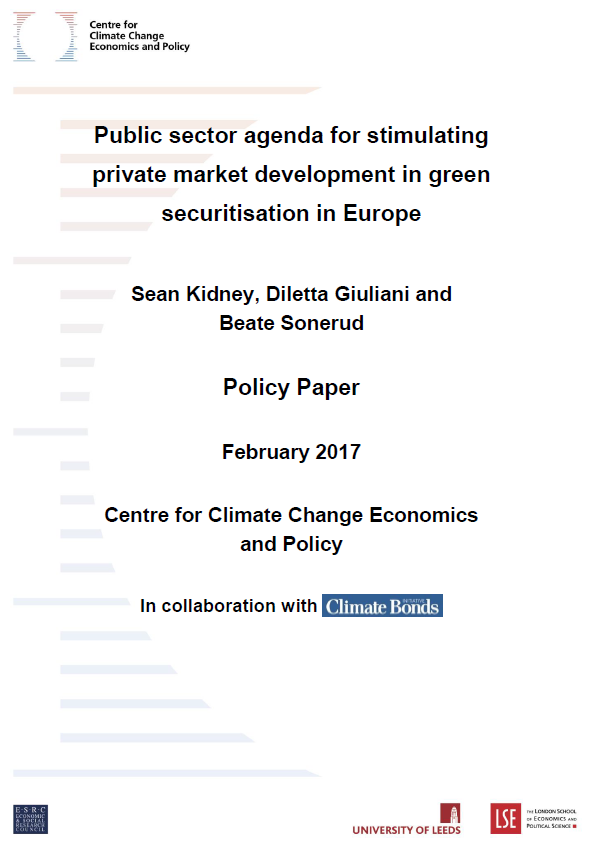The Climate Bonds Initiative, in collaboration with the ESRC Centre for Climate Change Economics and Policy (CCCEP) at the London School of Economics, has released ‘Public sector agenda for stimulating private market development in green securitisation in Europe’
What’s in the report?
The report paper analyses the rationale for green securitisation – including investor demand – and explores the current challenges for expanding green securitisation in Europe, a part of developing wider climate finance and green investment.
It sets out a strategic role for the public sector to facilitate the development of a green securitisation market and increase private sector investment and deal flow.
Developing green securitisation in Europe can help close the infrastructure gap and meet the EU 2030 climate targets.
Green securitisation: a USD 380bn + opportunity
Maturing green bond markets are increasing the potential for green asset-backed securities (ABS). The green ABS market globally has grown to USD 5bn of issuance in 2016, but it is dominated by issuance outside of Europe.
A Euro Market of USD 84bn by 2035 - OECD
In Europe, green ABS annual issuance could reach USD 84bn by 2035 (37% of green securities) according to the OECD.
Globally, annual issuance of green ABS could reach between USD 280-380 billion by 2035 for renewable energy, energy efficiency and low-emission vehicles (LEVs) alone, the OECD estimates. Investments for low carbon public transport, adaptation, land-use and waste would add to the figure.
Policy makers have a central role
The public sector has historically been instrumental in promoting securitisation in new asset classes, including mortgages and student loans.
In Europe, there is momentum to revitalise the securitisation market through the European Commission’s proposed regulation for a "Simple, Transparent and Standardised Securitisation", and to introduce sustainability elements into the capital markets legislation through the High-Level Expert Group on Sustainable Finance.
Climate Bonds CEO Sean Kidney is one of the NGO representatives appointed to this group.
Both these projects provide opportunities and should be capitalised on to help develop a green securitisation market.
5 Core Recommendations for Policy Makers
The paper outlines 5 recommendations for the public sector to help develop and grow a European market for green asset backed securities:
- Work with market players to develop clear and consistent definitions of what qualifies as green
- Establish or offer financial support to existing initiatives and groups working on standardisation of green loan contracts
- Support financial warehousing of standardised loans; warehouses can be set up as public-private partnerships or hosted by local development banks
- Offer guarantees for junior and mezzanine tranches of green asset-backed securities to make the senior tranches attractive to institutional investors
- Invest in green ABS and consider incorporating environmental factors into capital weights to favour climate-friendly investments
Who’s saying what?
 Simon Dietz, Co-Director of the ESRC Centre for Climate Change Economics and Policy at the London School of Economics
Simon Dietz, Co-Director of the ESRC Centre for Climate Change Economics and Policy at the London School of Economics
“This paper was supported by our Innovation Fund which aims to stimulate the flow of innovative ideas on climate policy. Greater investment is needed in low-carbon technologies and infrastructure in Europe and globally and new ideas about how to increase access to investment, such as the securitisation of green loans as discussed in this paper, have the potential to make a real contribution to the advancement of climate policy and to aid the transition to a low carbon economy.”
 Diletta Giuliani, Climate Bonds Policy Analyst and lead author on the paper
Diletta Giuliani, Climate Bonds Policy Analyst and lead author on the paper
“What is needed now is for the market in asset-backed securities for green assets to be kick-started in Europe. National governments of EU member states could help expand trading in green ABS, and open a new financial stream outside banks’ and companies’ balance sheets.”
“It is crucial for policy makers to implement measures that will help aggregate and transform small scale projects into securities that can attract institutional investors, and help generate investment in low carbon assets required to meet the climate policy goals that have been established by the EU.”
The Last Word – Strong and Effective Policy
On their own, traditional sources of funding for new green technologies from banks, utilities and government are unable to fund the multi-billion Euro investments needed.
Grouping these investments into packages means the debt can be sold on to much bigger investors who buy and sell securities on the multi-trillion Euro bond market.
This Climate Bonds - CCEP report highlights how strong and effective public policy around green ABS, underpinned by a credible climate policy, offers another opportunity for mobilising the capital needed to fund the EU transition to a low carbon economy.
'Till next time,
Climate Bonds
Disclaimer: The information contained in this communication does not constitute investment advice and the Climate Bonds Initiative is not an investment adviser. Links to external websites are for information purposes only. The Climate Bonds Initiative accepts no responsibility for content on external websites.
The Climate Bonds Initiative is not advising on the merits or otherwise of any investment. A decision to invest in anything is solely yours. The Climate Bonds Initiative accepts no liability of any kind for investments any individual or organisation makes, nor for investments made by third parties on behalf of an individual or organisation.
